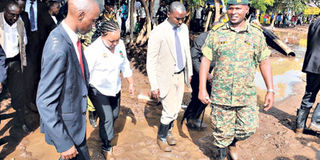Leaders ignore expert advice on floods at residents’ peril

Devolution Cabinet Secretary Anne Waiguru tours a flood disaster site in Narok on Friday. ERIC BOSIRE | KNA
What you need to know:
- While the researchers and other professionals publicise their papers and defend them before panels of eminent water and environmental scholars as well as leaders, nothing has been done to ease the torrents. Last week, they claimed nine lives and destroyed businesses in Narok.
- Last week, nature cruelly hit back, with floods flattening a building. Business premises were filled with water.
- A watchman interviewed by the Nation said the water was fighting back to reclaim its original “home” on the foot of the “bowl”.
Several masters and post-doctoral studies have recommended measures to ease the impact of floods in Narok, but the documents are gathering dust as people die and property worth millions are destroyed annually.
A report by the National Council for Science and Technology also shows that more people have sought permission to study the Mara River Basin with a view to coming up with reports on ways of improving lives while allowing some ventures to thrive.
While the researchers and other professionals publicise their papers and defend them before panels of eminent water and environmental scholars as well as leaders, nothing has been done to ease the torrents. Last week, they claimed nine lives and destroyed businesses in Narok.
Through their work, the scholars sought to fulfil their wish of turning Narok Town into a well-preserved business and tourism hub that is “human-friendly” during all seasons.
A search on the Internet will show numerous studies as well as expert proposals by international and local organisations that were submitted to the national and county governments.
In the studies, the experts expressed dismay over the “unnecessary” deaths within Narok’s most vibrant business centre, but no one seemed to have taken note of the veracity of the findings as the government sanctioned the allocation of plots along the waterway and approved building plans, paving the way for their development.
Narok is located on the middle lower base of a “bowl” surrounded by hills with an indigenous forest cover that is being ruined by charcoal burners and loggers.
As one drives into Narok from Mai Mahiu, one gets an idea of the destruction taking place in the expansive Mau Maasai Complex, where freshly burnt charcoal is sourced by many motorcyclists. Lorries ferrying sand to Nakuru, Nairobi and Kiambu counties zoom past, with the drivers oblivious of the destruction left behind.
The multi-million-shilling businesses employ hundreds of youths. Groups within and outside the government benefit from the businesses, making it impossible to ban them, despite the threat they pose to the world famous Maasai Mara Game Reserve.
Some people have even harvested sand next to the main Narok-Mai Mahiu road for a quick shilling, unmindful of the danger they expose motorists to when floods strike the area.
According to the studies, little seems to have been done despite the presence of officers from the Kenya Forest Service, Kenya Wildlife Service, and the Administration Police and the regular unit. Narok county enforcement officers are also present.
“To avoid arrest, motorcyclists carry five sacks of charcoal per trip as required by the law. With such a quantity, they are not required to have a transportation permit,” said a local environment activist.
NATURE HIT BACK
Last week, nature cruelly hit back, with floods flattening a building. Business premises were filled with water.
On Kim Dishes Road, Hass Petrol Station and a number of shops were extensively damaged.
Narok Traders Association Chairman David ole Sankok blamed the poor drainage for the severe effect of the perennial floods.
He said the delay in planning the 692-square-kilometre urban centre, poor waste management and uncoordinated development have complicated the matter.
“Poor planning by the defunct council significantly contributed to our inability to collect land rates and parking fees, leading to ineffective service delivery,” said County Executive for Lands, Trade and Planning Allan Twala.
He said the county government loses up to Sh5 million in parking fees monthly. He added that business people lose thrice the amount every year to flooding, among other factors.
Mr Twala said uncontrolled development in the town hindered revenue collection. He said some developers who had built along the waterway opposed the demolition of their buildings and plans to move key government offices to Limanet, which is on higher ground.
A watchman interviewed by the Nation said the water was fighting back to reclaim its original “home” on the foot of the “bowl”.
In his Master’s degree thesis Prospects and Limitations of Integrated Watershed Management in Kenya: A Case Study of the Mara Watershed, Mr Isaac Wafula says: “There is need to control migration of people into the watershed — the Mau Maasai Forest Complex, come up with strategies to eradicate poverty and deter ongoing exploitation of natural resources that is unsustainable.”
Mr Wafula, who studied at Lund University in Sweden, said the wanton destruction of trees threatened forest and wildlife population, and reduced water yield as well as quality during the dry season.
“But this requires political goodwill if the problem of the Maasai Mau and Mara Watershed is to be addressed,” he says.






